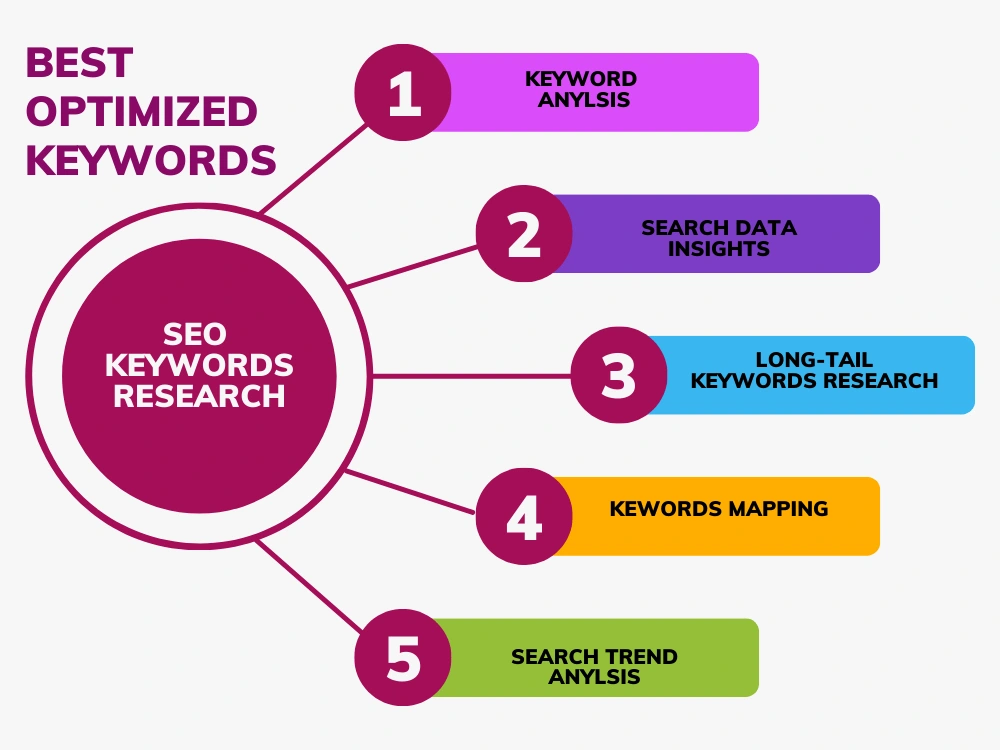SEO Keyword Research: The Cornerstone of Internet Success
Introduction
In today’s digital world, SEO (Search Engine Optimization) is a vital part of any online marketing strategy. Whether you’re a blogger, business owner, or digital marketer, showing up on the first page of Google is a goal we all chase. But how do you get there? It all starts with one essential step — keyword research.
BEST OPTIMIZED KEYWORDS RESEARCH

Keyword research: what is it?
The process of identifying and examining search phrases that users type into search engines like Google is known as keyword research. These keywords assist you in determining the search terms used by your target audience and how to produce content that speaks to their interests.
To put it simply, it’s similar to speaking to your audience in their language through your content.
For instance, if you own a bakery in Mumbai, consumers may look up terms like “custom cakes near me” or “best bakery in Mumbai.” These could be your keywords.
What Makes Keyword Research Vital?
The following explains why keyword research is essential to SEO:
Enhanced Visibility: Your website may rank on the first page of search results if you use the appropriate keywords.
Targeted Traffic: It draws in the appropriate customers who are genuinely trying to find your goods or services.
Improved Content Ideas: Researching keywords enables you to determine the kind of content that your target audience is interested in.
Increased Conversion Rates: People are more inclined to act when they find precisely what they’re looking for.
Competitive advantage: You may develop a more intelligent SEO strategy if you are aware of the terms that your rivals rank for.
Recognizing the Intent of Search
Knowing search intent, or why someone is seeking, is one of the most crucial aspects of keyword research.
Four categories of search intent exist:
Informational: Seeking knowledge, such as “how to bake a cake.”
Navigational: Searching for a certain website (for example, “Facebook login”).
Transactional: Prepared to make a purchase (for example, “buy shoes online”).
Comparing: before purchasing (e.g., “best laptops under 50,000”) is a commercial investigation.
It’s critical to align your material with the right intent. Provide information to those who wish to learn. Provide a product or service page if they’re prepared to make a purchase.
How to Conduct Step-by-Step Keyword Research
1. Generate a list of ideas
Start with general subjects associated with your specialty. For instance, if you run a blog about fitness, some of your subjects could be:
Loss of weight
Plans for a working exercise
Healthy recipes
At-home workouts
2. Make Use of Tools for Keyword Research
It’s time to translate those subjects into targeted keywords now. Use tools, either free or paid, such as:
Google Keyword Planner (Free)
Ubersuggest (Paid and Free)
Ahrefs (Paid)
SEMrush (Premium)
AnswerThePublic (Free)
Trends on Google (Free)
These instruments will display:
Volume of monthly searches
Keyword challenge
Cost per click, or CPC
Suggestions for related keywords
3. Seek Out Long-Tail Terms
Long-tail keywords are more specialized, longer phrases such as:
“How to reduce abdominal fat at home”
“greatest yoga poses for novices”
Because there is less competition, these may have a lower search volume but a greater ranking chance.
4. Examine the Keywords of Your Rivals
Use tools such as Ahrefs or SEMrush to see what your competitors are ranking for. Examine their most popular pages to see which keywords get the most traffic. After that, you can develop more thorough or superior content centered around related keywords.
5. Sort and Order Keywords
Put related keywords in one group. For instance:
“Digital marketing course“ is the main keyword.
Related terms: “top course on digital marketing,” “near me digital marketing course,” “training in online marketing”
Next, set priorities according to:
Pertinence
Volume of searches
Level of competition
Tips for On-Page SEO Following Keyword Research
Here’s how to use keywords successfully after you have them:
Title Tag: Make sure the page title contains your primary keyword.
Meta Description: Use the keyword to create an engaging description.
URL: Use the keyword and keep it brief.
Headings (H1, H2, etc.): Naturally, make use of keywords.
Content Body: Compose educational material that responds to the user’s query.
Image ALT Text: Use pertinent keywords to describe photos.
Internal Links: Provide links to more pertinent posts or pages on your website.
Typical Errors to Avoid
When Stuffing Keywords: Excessive keyword repetition can lower your ranks.
Ignoring Search Intent: Composing content that is inappropriate for the search.
Focusing Only on Broad Keywords: These are very competitive and challenging to rank.
Not Updating Old Content: Adding new keywords to old content can improve rankings.
Conclusion
Researching keywords is a continuous process rather than a one-time event. Algorithms are updated, trends shift, and user behavior changes. You can better serve your audience with your content if you have a better understanding of what they are searching for.
Understanding keyword research will provide you a competitive advantage whether you’re managing a blog, an online store, or a corporate website. Be consistent, start small, and keep in mind that “Good SEO starts with good keyword research.”
Ready to get started learning the Digital Marketing Course? Register for a free demo
Get More Details Regarding Digital Marketing Course
Phone no.
9988-500-936
Address
SCF 22, First floor, GTB Market, Khanna
Website
www.microwavecomputer.com
Opening Hours
08:30 am - 06:00 pm
